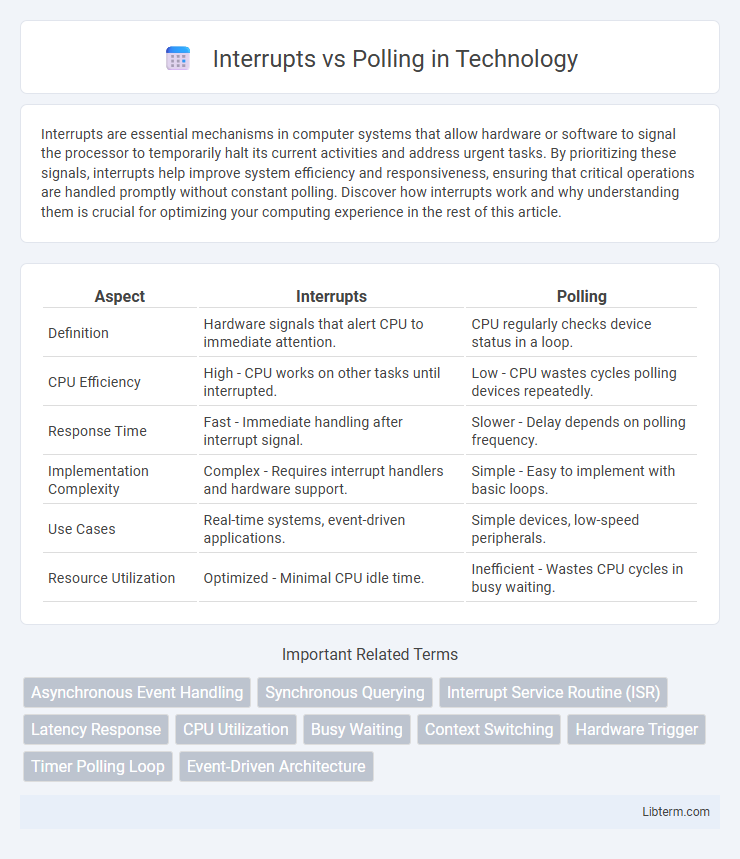Interrupts are essential mechanisms in computer systems that allow hardware or software to signal the processor to temporarily halt its current activities and address urgent tasks. By prioritizing these signals, interrupts help improve system efficiency and responsiveness, ensuring that critical operations are handled promptly without constant polling. Discover how interrupts work and why understanding them is crucial for optimizing your computing experience in the rest of this article.
Table of Comparison
| Aspect | Interrupts | Polling |
|---|---|---|
| Definition | Hardware signals that alert CPU to immediate attention. | CPU regularly checks device status in a loop. |
| CPU Efficiency | High - CPU works on other tasks until interrupted. | Low - CPU wastes cycles polling devices repeatedly. |
| Response Time | Fast - Immediate handling after interrupt signal. | Slower - Delay depends on polling frequency. |
| Implementation Complexity | Complex - Requires interrupt handlers and hardware support. | Simple - Easy to implement with basic loops. |
| Use Cases | Real-time systems, event-driven applications. | Simple devices, low-speed peripherals. |
| Resource Utilization | Optimized - Minimal CPU idle time. | Inefficient - Wastes CPU cycles in busy waiting. |
Introduction to Interrupts and Polling
Interrupts and polling are two fundamental techniques for managing input/output operations in computer systems. Interrupts allow devices to signal the CPU asynchronously, prompting immediate attention and efficient handling of events without constant CPU checking. Polling involves the CPU repeatedly checking the status of a device at regular intervals, leading to potential delays and higher CPU overhead compared to interrupt-driven communication.
Defining Interrupts
Interrupts are hardware or software signals that temporarily halt the CPU's current operations to prioritize and execute a specific task, enabling immediate response to critical events. They improve system efficiency by allowing the processor to perform other functions until attention is required, reducing the need for continuous checking of device status. Interrupt-driven systems contrast with polling, where the CPU repeatedly checks device status, often leading to wasted processing time and lower performance.
Understanding Polling
Polling continuously checks the status of a device or resource, allowing the CPU to control when it processes data, which can lead to inefficient use of processor time. This method is simple to implement but consumes more CPU cycles and can cause delays in handling urgent tasks due to constant checking. Polling is suitable for systems with predictable or low-frequency events where immediate response is less critical compared to minimizing overhead.
Key Differences Between Interrupts and Polling
Interrupts enable a processor to respond immediately to critical events by suspending ongoing tasks and executing an interrupt service routine, while polling requires the processor to continuously check the status of a device, leading to potential inefficiencies. Interrupt-driven systems improve CPU utilization by handling events asynchronously, whereas polling can cause delays and increased CPU cycles due to constant status checking. Key differences include responsiveness, CPU overhead, and system efficiency, with interrupts providing faster event handling and polling offering simpler implementation but with higher processing costs.
Advantages of Using Interrupts
Interrupts offer significant advantages over polling by providing efficient CPU utilization, as the processor only handles events when necessary instead of continuously checking device status. This leads to faster response times and improved system performance, especially in real-time applications. Using interrupts also reduces power consumption since the CPU can enter low-power states until an interrupt signals attention.
Benefits of Polling Mechanisms
Polling mechanisms offer consistent control over device status by frequently checking for events, enabling predictable CPU scheduling without the need for asynchronous interrupts. This method simplifies hardware and software design, reducing complexity in managing multiple devices and avoiding interrupt overhead. Polling is especially beneficial in systems with low event rates or where deterministic timing is critical for real-time applications.
Common Applications of Interrupts
Interrupts are widely used in real-time systems, embedded devices, and hardware communication interfaces where immediate attention to events like keystrokes, sensor signals, or network packets is critical. They enhance system efficiency by allowing the CPU to perform other tasks until an event occurs, unlike polling, which continuously checks the device status and wastes CPU cycles. Common applications include keyboard input handling, timer events, serial communication, and external device signaling in operating systems and microcontroller environments.
Typical Use Cases for Polling
Polling is typically used in scenarios where maintaining consistent and predictable timing is essential, such as in simple embedded systems or environments with low interrupt overhead. It is effective when monitoring multiple devices with infrequent or predictable state changes, allowing the processor to periodically check each device in a controlled sequence. Polling is also preferred in systems where interrupt latency must be minimized or when devices do not support interrupt-driven communication.
Performance Comparison: Interrupts vs Polling
Interrupts offer superior performance in real-time systems by allowing the CPU to focus on other tasks until an event occurs, minimizing idle wait times, while polling continuously checks the status, leading to higher CPU usage and inefficiency. Polling can cause latency and wasted processing power, especially in systems with infrequent events, whereas interrupts trigger immediate response only when necessary. In high-throughput or power-sensitive applications, interrupt-driven designs enhance overall system efficiency and reduce energy consumption compared to polling mechanisms.
Choosing the Right Approach for Your System
Choosing the right approach between interrupts and polling depends largely on system requirements such as responsiveness, CPU utilization, and power efficiency. Interrupts enable immediate CPU attention to high-priority events, minimizing latency and conserving processing power by allowing the CPU to perform other tasks until an event occurs. Polling involves the CPU repeatedly checking device status, which can be simpler to implement but may lead to increased CPU usage and slower response times, making it suitable for low-speed or less time-critical applications.
Interrupts Infographic

 libterm.com
libterm.com